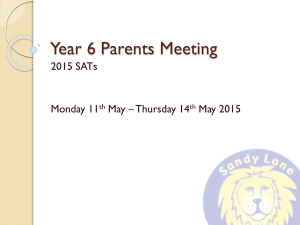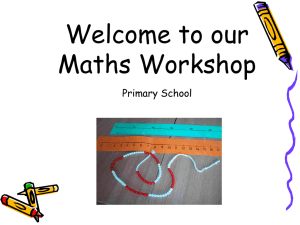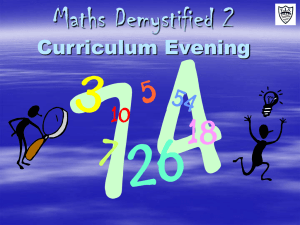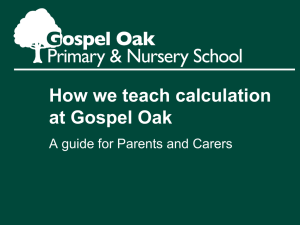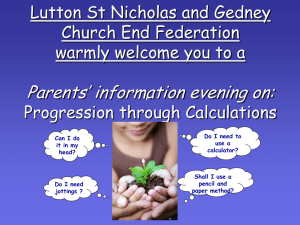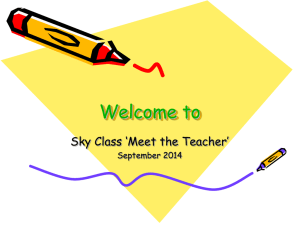Maths Curriculum Evening
advertisement
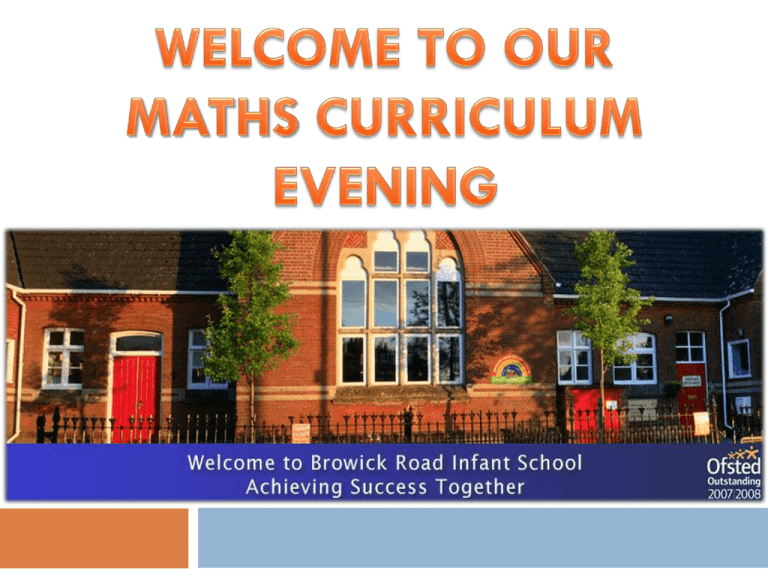
Why maths? It is essential for everyday life Very important for science and technology Financial literacy All jobs Ofsted Ofsted (July 2013) ‘The very large majority of pupils achieve exceptionally well in reading, writing and mathematics.’ ‘The progress of all pupils, including children in the Reception classes… is outstanding and has been so for the last five years.’ ‘Provisional 2013 data suggests that these high standards will be …. improved upon in mathematics’. Maths is fun! At Browick we provide a daily 1 hour maths lesson as part of providing a firm foundation for understanding the world Help the children to reason mathematically Give them a sense of enjoyment and curiosity about maths Maths Resources Number lines Hundred squares Numicon Diennes Arrow cards Cubes and unifix Interactive games Ipads Maths in Reception Teaching and Learning is hands-on and fun. We start off with number songs e.g ‘5 little ducks’ and counting forwards and backwards to 5 then 10, 20 and beyond! We learn ordinal counting - saying number names in order ‘1,2,3,4,5…’ and the cardinality (‘numberness’) of numbers - knowing that e.g. 5 is a quantity. There is a big difference between these two things: Maths in Reception We use numicon, it is fantastic for understanding every aspect of number and calculating ie. adding, subtracting, more than, less than, patterns, the size of numbers, ordering numbers, place value. This gives a great grounding in understanding numbers and how to use them. Reception Maths happens in the classroom and outside There is always a maths area available which may have games, puzzles, numicon, sorting, shapes. It is also built in to our topics. For example: * Using numbers and measuring when cooking. * Ordering or sorting animals or shapes. Early Learning Goal for Number Children count reliably with numbers from 1 to 20, place them in order and say which number is one more or one less than a given number. Using quantities and objects; they add and subtract two single digit numbers and count on or back to find the answer. They solve problems including doubling, halving and sharing. Mental Calculation The ability to calculate ‘in your head’ is an important part of mathematics. The children learn number facts by heart and develop a range of mental strategies for quickly finding a range of related facts eg. working out corresponding subtraction facts from known addition facts. Informal recordings and the use of tools such as number lines and hundred squares are used to develop children’s sense of number and help them become confident and comfortable when operating with numbers ‘in their heads’. Mental Calculations Children develop a range of mental calculation skills and use these confidently in different settings. Largest number first. Number bonds to ten. Doubles or near doubles. Mental Maths Task Do this calculation in your head. 2 + 16 Mental Maths Task Do this calculation in your head. 16 + 2 Mental Learning Task How did you work it out? Year 1 Number and Place Value Children learn to: count, read and write numbers to 20 use knowledge of place value to position these on a number track and number line. identify one more and one less One Less One More 9 10 11 Year 1 Addition Use the vocabulary related to addition and subtraction and symbols to describe and record addition and subtraction number sentences. Solve problems that involve addition and subtraction, using concrete objects and pictorial representations 4 3 7 Mathematical Vocabulary Children begin to grasp mathematical language ‘Sum’ is only used in addition calculations. Using a number line to add 8 + 4 = 12 1 2 3 4 Year 2: Count, read, write and order numbers to 100 and beyond. Year 2: Number and place value. Count in steps of 2, 3 and 5 from any number forwards and backwards. Recognise the place value of each digit in a two-digit number (tens and ones/units) What is the value of the underlined digit 74 Compare and order numbers from 0 up to 100 and use < and > and = signs. 72 > 21 ( 72 is greater than 21) 35 < 89 (35 is less than 89) Year 2: Addition and subtraction. Solve problems with addition and subtraction I have 17 cars, 3 tractors and 10 trains. How many vehicles have I altogether? 2 of my cars went missing and I gave a train to both my brother and sister. How many vehicles have I got now? Problem solving and applying addition in Year 2 Choose two things to buy from the shop. Use a number line to work out how much they will cost together. Ruler and sharpener cost 57p Addition using a number square Add 16 51 +16= 67 Adding 10 go down 1 Subtracting 10 up 1 Adding 1 go right 1 Subtracting 1 go left 1 Subtraction using a number square Subtract 31 87 – 31 = 56 Adding 10 go down 1 Subtracting 10 up 1 Adding 1 go right 1 Subtracting 1 go left 1 Year 2 addition and subtraction Recall and use addition and subtraction facts to 20 fluently 16 + 4 = 20 12 + 8 = 20 19 - 7 = 12 13 – 5 = 8 Add and subtract one and two-digit numbers 24 + 32 = ? 38 - 16 = ? Know that addition of two numbers can be done in any order (commutative) and subtraction of one number from another cannot. 17 + 14 = 31 17 – 14 = 3 14 + 17 = 31 14-17 does not = 3 Recognise and use the inverse relationship between addition and subtraction and use this to check calculations and solve missing number problems. 3+7 = 10; 10 – 7 = 3 and 7= 10 - 3 Arrow cards for place value Zero as place holder Children learn that zero is used to represent no number in a hundred tens or units column. To learn about place value we play games such as Place the Penguin. Partitioning – into tens and units T.U.B Method Tens. Units. Both 42 + 31= 73 Step 1: partition numbers into tens and units ( tens - 40 + 30) (units - 2+1) Step 2: add up the Tens (T) ( 40 + 30 = 70) Step 3: add up the Units (U) ( 2+ 1 = 3) Step 4: add both (B) (70+ 3= 73) Partitioning. 56 + 32 = 88 First split the numbers into tens and units. 50 + 6, 30 + 2 Add the tens 50 + 30 = 80 Add the units 6 + 2 = 8 Recombine the tens and units. 80 + 8 = 88 Multiplication in Key Stage1 First recognize that multiplication is repeated addition 5 x 4 = 20 Is the same as 4 lots of 5 or 5 + 5 + 5 + 5 = 20 Use pictorial cues to represent a multiplication calculation. 20 Multiplication Recall and use multiplication and division facts for the 2, 5 and 10 times tables. Arrays What number sentences could you write to go with this array? 2 x 6 = 12 6 x 2 = 12 6 + 6 = 12 2 + 2 + 2 + 2 + 2 + 2 = 12 The use of the multiplication sign Confusion exists about the way multiplication is written. 6 x2 and 2 x 6 are often interpreted in exactly the same way. It may be argued that the ‘correct’ interpretation for 2 x 6 is ‘2 multiplied by 6’, that is two taken six times or 2 + 2 + 2 + 2 + 2 + 2. However, since multiplication is commutative, children learn that both ways are valid. Multiplication Children use their known times tables to solve multiplication problems. Eg. 5 x 4 = 20 They use known times tables to work out other facts. Eg. If they know that 9 tens are 90 they also know that 10 nines are 90. Some children progress to solve trickier multiplication problems. Eg. 5 x 16 = ? They do this by partitioning the sixteen into tens and units; 5 x 16 = 5x10 + 5 x 6 = 50 + 30 = 80 Multiplication practise Children practise their times tables regularly in Year 2 by doing a variety of short activities such as: Reciting together Playing ‘Snake pit’ - whole class circle game Solving multiplication problems. Division Children learn that division and multiplication are inverse operations. So they can recall division facts from their known times tables. For example – if 2 x 6 = 12 They also know that 6 x 2 = 12 And 12 ÷ 2 = 6 And 12 ÷ 6 = 2 Division by sharing Children begin to talk about their methods and explain their reasoning when solving problems. Division by repeated subtraction 24 ÷ 4 = 6 Maths Lessons in Y1 and Y2 In maths lessons we focus on number and calculations. 12 + 11 = 23 23 – 11 = 12 Shape, space and measure is linked across the curriculum with 1 week per half-term devoted to these areas of the maths curriculum. Shape describing the shape and size of solid and flat shapes. How many sides? How many faces? Edges? Corners? (Vertices) Position and Direction Using everyday words to describe position Above below left right between under Using early mathematical ideas to solve practical problems. How many legs do 2 spiders have? 8+8= 8 x 2 = or 2 x 8 = Measure – time and data handling Length Capacity Weight Time Data handling Cross-curricular maths The children learn about shape and space through practical activities which build on their understanding of their immediate environment Measuring in the allotment/playground Shape in art (Mondrian) Space – position and direction Practical maths to do at home How many plates, knives and forks are needed to set the table? Measuring ingredients for cooking Which glass holds most liquid Counting money Maths games to play at home Snakes and Ladders Other games that involve taking turns and using dice Jigsaws Websites to use at home School Website Visit the school website for more information about maths http://www.browickrd.norfolk.dbprimary.com
